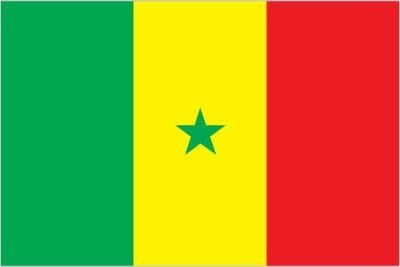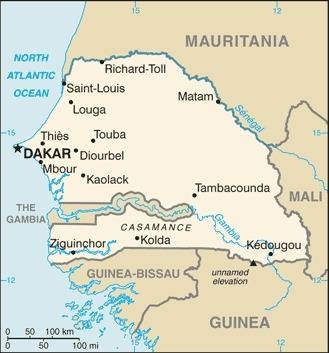218 Senegal

Three equal vertical bands of green (hoist side), yellow, and red with a small green five-pointed star centered in the yellow band. Green represents Islam, progress, and hope. Yellow signifies natural wealth and progress. Red symbolizes sacrifice and determination. The star denotes unity and hope.
Flag courtesy of the CIA World Factbook

Map courtesy of the CIA World Factbook

A sulcata tortoise (Geochelone sulcata), a land-dwelling reptile native to Northern Africa.
Photo courtesy of the CIA World Factbook
Government
According to Britannica, the first constitution of Senegal was promulgated in 1963 and revised through March 1998. A new constitution, approved by voters in January 2001 and since amended, proclaims fundamental human rights; respect for individual and collective property rights; political, trade-union, and religious freedoms; and a democratic and secular state.
Senegal is a multiparty republic. The 2001 constitution provides for a strongly centralized presidential regime, the head of state and government is the president, who is elected by direct universal adult suffrage and can be elected to two seven-year terms. Ministers are appointed by the president. Senegal has a unicameral legislature (the National Assembly), with most members directly elected; the remaining members are indirectly elected. All legislators serve five-year terms. Judicial, executive, and legislative powers are separated.
Senegal is divided into 14 régions, which in turn are divided into départements and arrondissements. Each région is administered by a governor whose role is coordinative and who is assisted by two deputy governors, one dealing with administration and the other with development. Regional assemblies, the powers of which were increased in 1996, are composed of general councillors responsible for local taxation. In each département the prefect represents the republic, as do the ministers. There are also autonomous urban communes. Dakar is governed by an elected municipal council.
Judicial power in Senegal is exercised by the Constitutional Council, the Council of State, the Court of Cassation, the Court of Accounts, and the Courts and Tribunals. Senegal also has a High Court of Justice, whose members are elected by the National Assembly. The High Court tries government officials for crimes committed while in performance of their government duties.
National Agency for Civil Aviation and Meteorology (ANACIM)
The National Agency for Civil Aviation and Meteorology (ANACIM), created by decree n° 2011-1055 of July 28, 2011, modified by decree n° 2015-981 of July 10, 2015, is the authority of the Civil Aviation in Senegal enshrined in Law No. 2015-10 of May 4, 2015 on the Civil Aviation Code.
Airspace
SkyVector – Google Maps – ADS-B Exchange
ICAO countries publish an Aeronautical Information Publication (AIP). This document is divided into three parts: General (GEN), En Route (ENR) and Aerodromes (AD). ENR 1.4 details the types of airspace classes they chose to adopt from classes A through G.
Drone Regulations
Advanced Air Mobility (AAM) Regulations & Policies
None found by the author.
However, should you, the reader, happen to stumble across something to the contrary, please email the author at FISHE5CA@erau.edu and you may be mentioned in the ACKNOWLEDGEMENTS section of this book by way of thanks for contributing to this free eBook!
Advanced Air Mobility (AAM) News
2025
Video courtesy of Advanced Air Mobility Institute from the January 2025 Global AAM Forum. Complete session for Day 1 of this Forum is available on the Advanced Air Mobility Institute YouTube Channel
Short Essay Questions
Scenario-Based Question
You have been hired by a Drone Startup Company. Your boss has immediately assigned this job to you.
They need you to prepare a one-page memo detailing the legalities of using a drone to film the Mamelles Lighthouse in Dakar, Senegal.
They need you to mention any national laws and local ordinances.
They specifically want to know what airspace (insert pictures) you will be operating in and whether or not you need an airspace authorization.
Does it matter whether or not you are a citizen of the country?
Lastly, there is a bonus for you if, as you scroll through this chapter, you find any typos or broken links!
Short Essay Questions
- What are the drone categories?
- How is registration addressed?
- How is remote ID addressed?
- What are the model aircraft rules?
- What are the commercial drone rules?
- Are there waivers or exemptions to the rules? If so, for what?
- Would you share a link to an interactive airspace map?
- How is BVLOS addressed?
- How can you fly drones at night?
- How can you fly drones over people?
- Where do you find drone NOTAMs?
- What are the rules for drone maintenance?
- What are the rules for an SMS program?
- What are some unique rules not mentioned above?
- What are the C-UAS rules?
- What are the AAM rules?

